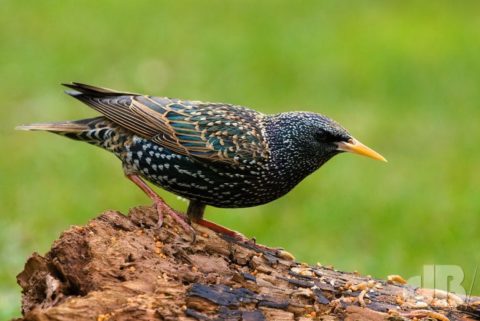Sometimes you have to step back from how you normally do something to find a way to do that thing better. For a year or more, I’ve tended to set my camera shutterspeed to about 1/1000th of a second for bird photography. It’s a lower limit on capturing the rapid wing movements of small birds flitting from tree to tree and on and off the feeders. It works quite well, but the lens aperture then has to be as large as possible to compensate for the short length of time the sensor is exposed to light. Even then, if it’s not a bright day or I’m in woodland, the photo will not expose well and I have to bump up the ISO (the sensor sensitivity) to get the shot.
Higher ISO equates to more noise if you’re shooting digital or more grain if you’re shooting on film. Grain can be atmospheric in monochrome stills of grizzled old actors and the like, but for a wildlife shot you really want crisp details and pinsharp eyes, otherwise it fails as a photo.
Enter the Youtube tutorials of wildlife photographer Paul Miguel. He’s got lots of free materials for photographers to explore and I’d watched one or two of them previously. But, then one about photographing small birds kept popping up as suggested viewing whenever I was on Youtube. So, I took a look…well, it couldn’t hurt and I might learn something…
…and so I did, he reiterates all the above about shutterspeed and aperture and ISO and lots more besides.
BUT.
And this is the re-learning bit for me. He points out that if your subject isn’t moving a lot you can use a much longer shutterspeed, which means a much lower ISO and so far less noise even on a dullish day. With a longer shutterspeed, you need a decent tripod with a gimbal or similar to balance and move a big lens smoothly for framing and/or beanbags or cushions to lie it on so that camera shake and thence blur don’t come into the equation on this side of the lens. With the camera on the beanbags, he suggests making the setup even more stable by pressing down firmly with your left hand while being gently poised and ready to depress the shutter with your right.
I set up a perch (a gnarly and grizzled old log in the middle of the lawn, scattered some bird food (mealworms and red millet seed) on it and around it, and tucked myself out of site with the camera on a couple of cushions on a low table.
Aperture was f/6.4, shutterspeed, t, 1/200th second, ISO was nice and low (set by the camera based on f and t at ISO500). I also rolled back the focal length from its maximum 600mm (900mm equiv on a 2/3 crop sensor) to around 400mm (600mm equiv) partly so I could get the whole bird in the frame (I was quite close to the log, about 4 metres away) but also so that the lens wasn’t at its limit (focus is usually a little softer on any zoom lens at maximum focal length. For a smaller bird I might have wanted to be a bit closer to get more of it in the frame, but that would be closer than the lenses minimum focusing distance so a short extension tube would be needed, see Miguel’s discussion on that point too, you lose about 1-stop of light with a 25mm extension on a 400…600mm type lens.
Anyway, an obliging Starling turned up for the feast and I fired off a few shots as it pecked and preened. Some were a bit blurry due to the bird’s movement, but a couple of them were pin sharp and showed off the wonderful iridescence – greens, bronzes, purples – of this species rather well.
Several nice comments came back once I’d shared one of the best of the photos on social media. Someone said it looked like a Faberge egg in avian form, others simply said “awesome”, “beautiful”, but the most flattering of the comments on my Instagram was from another David B who had this to say:
When they write the book on the best way to represent a Starling, they will reference this photo
So, here’s the photo, resized for the website and with my familiar dB/, decibel, logo.

Common Starlings, Sturnus vulgaris, are now actually quite rare in the UK, they’re on the RSPB’s red list. Winter numbers are swelled by visitors from Continental Europe and you may be lucky to see several thousand in murmurating flocks close to dusk. I’ve blogged about murmurations on several occasions here, please check the archives. Biggest of those I’ve seen locally counted at about 14000 birds over the reedbeds at Ouse Fen RSPB. In the summer months many of those flocks dissipate and the resident numbers fall significantly.
Nevertheless, we usually have a dozen or so in our garden coming and going on most days throughout the year and they nest in the spring locally in the gaps in the eaves of our houses, old woodpecker nests in trees, and other hollows. Peak numbers might be 20+ during the summer when the chicks have fledged and they will get through fat balls and birdfood very quickly. It can be quite expensive being a bird lover.